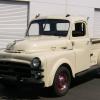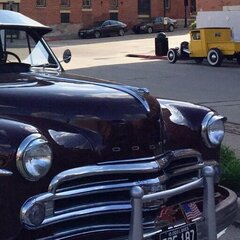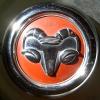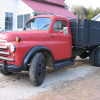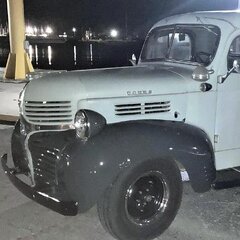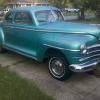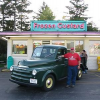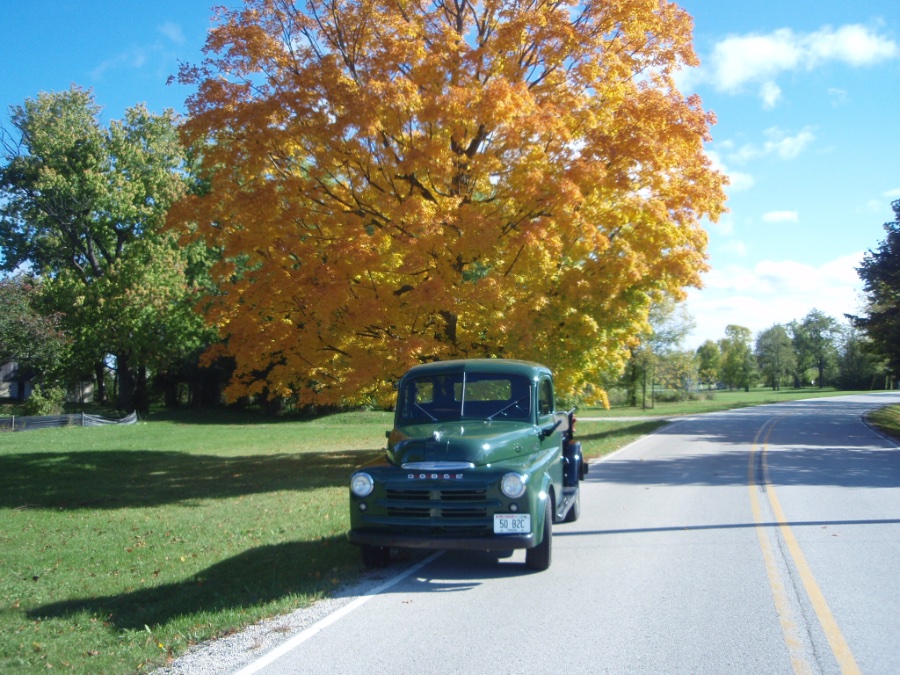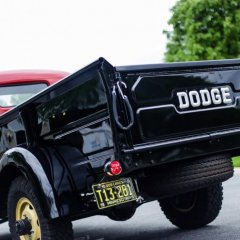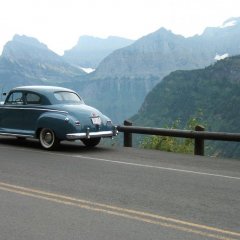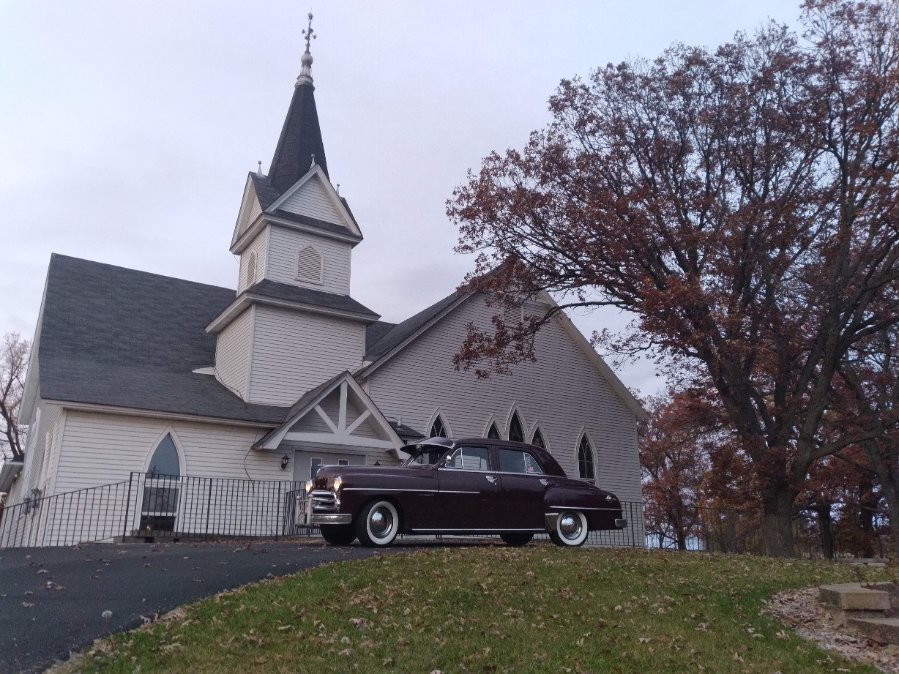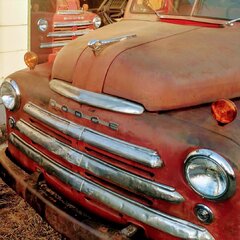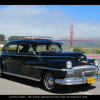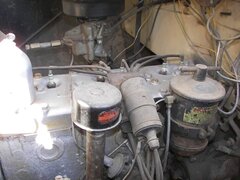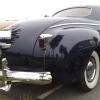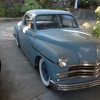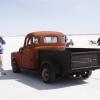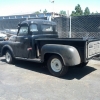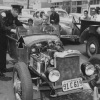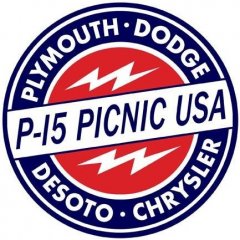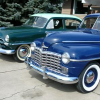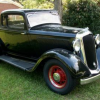Leaderboard
Popular Content
Showing content with the highest reputation on 10/25/2021 in all areas
-
I realized today that I should have provided an update on this thread, so here it is. As of September 23 the Meadowbrook is back up and running. I've put a bit over 300 miles on it and so far so good. I've had a couple minor coolant leaks around the t-stat housing and upper rad hose, nothing that a bit of tightening didn't solve. I do have a core plug seeping that I will address, likely in the spring. At first I had some blue smoke in the exhaust when snapping the throttle and on acceleration. That has since cleared up with drive time allowing the rings to seat. I assume the rough hone finish and chrome rings made for slow seating. As far as measurents go, everything is outside of spec. Cylinder taper, out of round, ring end gaps, valve guide wear, and rod bearing clearance all outside of spec. I figure this will be a good test of how forgiving these engines are. After running a hone through the cylinders and cleaning up the deck I can say with certainty this engine had water in cylinders 3 and 4 at one point and was stuck. I figure it ran pretty decent before the failure why not do what guys once did in corner service stations. So I proceeded with installing new pistons (came with wrist pins and retainer clips), rings (chrome top ring, cast lower compression and 2 one piece oil rings) and rod bearings. Hone the cylinders and cleaned the block as best I could with the crank still in it. It has a pretty rough looking exhaust valve seat in cyl 3 from corrosion pits. So far I'm happy with the results. Power is up, idles smoother, and most importantly it's back on the road. I'm curious to see how long this "rebuild" lasts. In the mean time I can drive the car, get my truck road worthy and start planning an actual rebuild for the engine that was originally in the car. Also, kudos to Vintage Power Wagons. I ordered most of the parts from them. Excellent customer service. I had an issue with a part and they made it right, no questions asked. Top notch guys working there.3 points
-
oh, yeah! back in high school, i parked my b3c at a friend's place, and came out an hour later and the truck was gone....down the hill, across the state highway, and into a neighbor's yard. got lucky - no damage to the truck or the neighbor's place. still have the truck.2 points
-
Ed, looks nice by any name You can call a couch a sofa, settee, lounge, or davenport but at the end of a long day it doesn't matter much when your on it.2 points
-
Motors Manual 35-53 says the Dodge 46-48 Distro is the IGS-4207A-1, providing it's still original to the car. Joe Lee2 points
-
Tooljunkie; You should take it out. It is good for them to get used. I am glad we don't have a season for using our classics here. I have used my truck year round for the past 7 years. It about drove me crazy to not be able to use it for a week or so. Had to use a couple of different "modern" vehicles.......and I must say I missed driving the real thing. I am just so used to it. I still can't believe how this brain fart experience went down.? But at least I can say it was the operator and not the truck that was at fault. Jeff2 points
-
@Los_Control You just wait till you see my parts washer in my next video! Here at home in our Hack Garages we do what we can, with what we have available to us. MacGuyver and Micky Mouse are not visitors in our garages. Their 2nd cousins may show up on the odd occasion. Lol.2 points
-
2 points
-
Oh Dopey me. I finally "discovered" the problem........and I can't believe it either. I park on a driveway that is sloped a fair amount. My parking brake works very well....it has to. Because my truck is a 4 speed fluid drive. Some how the truck was in 4th gear this whole time instead of neutral where I always leave it when parked. So it would start and as soon as the revs came up slightly it would bog down against the fluid drive.......but not give any indication at all that it was in gear like a normal manual transmission would. I can't believe I missed this. My surgery must have taken even more out of me than I intially thought. ? It is running exceptionally well now...so not a total loss. But man do I feel like a real dope. Thanks for all your suggestions. Jeff2 points
-
A few new people recently had me thinking to create a sticky post with the vendors we all know and love so it's easier to find for new members. Feel free to add as you see fit! Please add a SHORT blurb about what they do/have. Also check out any banner adds you see from website supporters! https://www.vintagepowerwagons.com/online-parts-catalog <---many Power Wagon parts that fit our trucks, engine parts https://dcmclassics.com/ <---huge selection of parts and re-pops https://www.robertsmotorparts.com/ <---huge selection of parts and re-pops (some NOS available) https://www.oldmoparts.com/ <---huge selection of parts and re-pops https://www.midwestmilitary.com/ <---ONLY source of correct bed-strips for DODGE trucks (others are Ford or Chevy parts), other random similar parts http://www.horkeyswoodandparts.com/ <---DODGE bedside pockets, bed wood kits, bed parts, bed strip offerings (NON Dodge style) http://www.mar-k.com/Catalog/index.aspx <---bed strip offerings (NON Dodge style), bed parts https://www.ebay.com/ <---roll the dice and see what might be out there https://p15-d24.com/classifieds/ <---our own location for buying/selling/searching for http://www.then-now-auto.com/ <---Fuel pump rebuild parts, etc https://www.steelerubber.com/ <---window seal parts https://brakeandequipment.com/ <---brake rebuild parts/shoe rebuild/lug studs https://www.cokertire.com/ <---vintage tires https://www.riwire.com/ <--- wire harnesses https://www.restorationspecialties.com/ <---random hardware and oddball stuff for old vehicles https://www.eatondetroitspring.com/ <--- NEW suspension springs for our trucks1 point
-
Last checkup today for my eye - all okay and I can start working on my car again and mowing grass. Had a vitrectomy about 2 weeks ago (8 October) where they replaced the gel in my left eye. Had really banged my head hard a few years ago, had A LOT of floaters, not just the stringy ones, one was like looking through clear egg yolk. Now have crystal clear vision, no floaters.1 point
-
1 point
-
Bryan, Good to hear your eye surgery was successful. Good vision is something to be truly thankful for.1 point
-
Cruising again this weekend. Annual trip to the apple orchard. And swung in by a lake for a couple quick photos1 point
-
Out for an evening drive. Fall colors are about peaked here. It was a beautiful drive through the country with the fall colors, the setting sun, migrating birds flying in formation, fields all golden and ready for harvest. It was a bit chilly since the Meadowbrook doesn't have a heater. I love fall but I'm not ready to park it for the season.1 point
-
10-24: Out for some fall photos. Thank goodness the truck has a decent heater; it's chilly today!1 point
-
1 point
-
Sounds like ya were able to adjust the nut behind the wheel adequately1 point
-
Hi. I thought I replied to this, but I think I didn’t do it correctly. Thanks everyone. I got the oil flowing and the truck started. the oil pump was the problem; I should not have installed a cover gasket. As soon as I removed that it started working perfectly. So thank again.1 point
-
10-22: My brother asked if he could take the Meadowbrook for a while because he enjoys driving it. His son also wants to learn how to drive it. What better than a car with Fluid Drive to learn a clutch? I drove the car to his place and we cruised around for a while and then he drove me home. Jeez, now I miss the Meadowbrook! But it's in good hands. I'd never let anyone else borrow it except for my brother ?1 point
-
Thank you, I have had that chart for 15 years or so. But, if you read my comments you can see that the issue is studs versus bolts and no wiggle room to move the flanges in to account for studs. A rear end swap will do nothing to solve that problem. James1 point
-
1 point
-
Thx. One screw up tho in the video. My ⅓ of a fan blade turn comment, 60 degrees. It is 120 actually degrees. Doh! Must have had my head up in the valve area too long. Breathing in oil vapors.1 point
-
1 point
-
I don't want to step on anyone toes, so my answer are for others who may stumble on this thread in future with fuel gauge problems. As mentioned earlier this fuel gauge unlike newer electromagnetic types. Newer work on coils on the principal of one sender resistor connected to ground activating a couple of coils. This older thermostatic type works on balance principal and has no coils in gauge, but 2 heated bimetal blades. Sender has 2 output and resistor is not grounded as in newer models. So there is always a certain current value flowing from both sender terminals to gauge and whatever current his highest, needle will move correspondingly. This principal is high end, more precise and makes gauge less bouncy. Shorting one terminal to ground will heat up the bimetal and needle will move faster and may do harm. Included here is 3 page copy of gauge and sender testing from Chrysler manual. And another 3 page from the 1950 Service reference book. Pages from Chrysler Shop Manual C28 C30 C33.pdf Pages from 1950 Gauges.pdf1 point
-
1 point
-
1 point
-
1948-50* recieved hood ornaments standard....it was an option in 51-53**. *1950: may have been a mid year transistion to an option ** 51-53 is a different casting number, same ornament design, almost impossible to find 48D1 point
-
1 point
-
1 point
-
This is an awesome truck, cant wait to see your progress on it. Im also really glad to hear you're going to keep that old farm truck look! By the way, awesome tractor. -Chris1 point
-
1 point
-
1 point
-
Its aged beautifully.....glad to hear you'll keep it close to the way it is. A good hand waxing should keep the elements out of the old paint and show it gets some well deserved love. Great story. 48D1 point
-
Now that is patina. Great story and truck. Good luck with the project. I like your tractor, too.1 point
-
Welcome to the forum. I really enjoyed your story and photos. Good luck with Grandpa's truck. Mike1 point
-
Hey, Jim, My first response is to think, “My engine leaks now, and I’m considering a rebuild?” I’ve been fooling with Model A flathead four bangers for too many years to count. On several forums dedicated to this motor the question of engine oil leaks comes up on a regular basis. The Ford motor is a famous leaker, and many have tried more modern improvements to help reduce the size of the puddle. One such remedy is the reduction of crankcase pressure by the use of a PCV (Positive Crankcase Ventilation,) system. I have experimented with a couple of these on Model A motors with a moderate degree of success. Your post and the garage floor under my ’33 PC have prompted me to begin considering a PCV for my engine. The principle, as I understand it, is that any internal combustion motor builds pressure within the crankcase when operating. The solution in the early days was to provide a passive system incorporating the use of a “road draft” tube and a ventilated oil fill cap. (The model A, and many earlier motors didn’t even have the tube, instead relying totally on the vent at the oil fill.) Most road draft systems work best at highway speeds, when the tube, (supposedly,) creates a vacuum from the slip stream, as the car moves forward. A newly rebuilt motor is likely to produce even more pressure inside, due to the better seal of the new pistons/rings and valving. Picture your motor with oil under pressure trying to escape, especially at idle, or low speeds: if the factory attempt at relieving this pressure is inadequate, all openings, (seals, gaskets,) are subject to this pressure from within. This condition is an open invitation to leaks. The concept of a PCV uses the introduction of a negative pressure to the crankcase in the form of engine vacuum. Some form of baffling at the point of entry/exit of the plumbing is sometimes necessary, depending on the location of the vacuum line port, to prevent suction of engine oil out of the motor. Usually a PCV valve is installed in the line to prevent back flow of air/gasses into the crankcase area when the motor is not running. In the few Model A Ford motors I've converted, I've installed a ⅛” pipe nipple to ⅜” fuel line into the valve cover of the motor, then, run a line to the intake for the vacuum source. (On one of these engines, the leaks almost completely disappeared, and the others showed marked improvements in the size of the puddle underneath and the dampness of the gasket surfaces on the engines.) The Mopar six has two such valve covers, and either may be a good candidate for the installation of the vacuum line. Looking at my motor, the running of a ⅜” line from the rear valve cover, up and around the back of the exhaust manifold to the vacuum port on the the intake would be pretty much a no brainer. I’ve read, and been told, that the choice of the PCV valve should be to look for a valve designed for a motor close in cubic inches to the one to be fitted. My past experience shows a parts counter man with some savvy can be helpful, here. Not to hijack your thread, but I’m thinking maybe the best way to prevent leaks is to possibly relieve the inside engine pressure that may be the main cause of them. I’m too new here to know if this is all “old information,” but a search of the site didn’t net any direct reference to a PCV installation. My 3 cents. . . GA1 point

